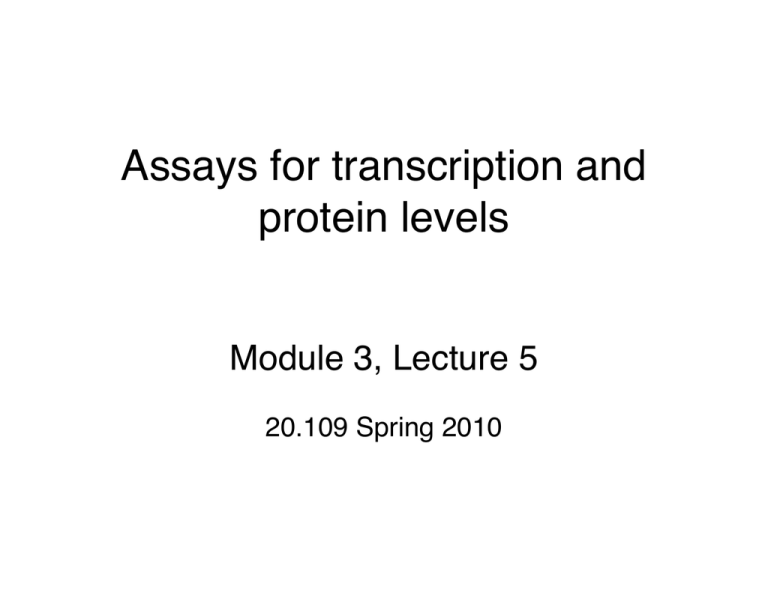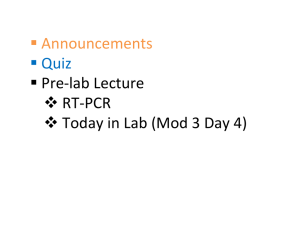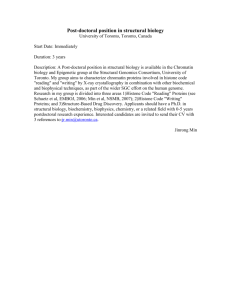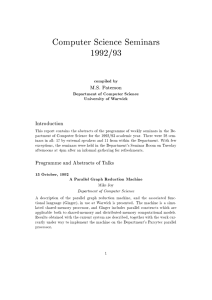Assays for transcription an d protein levels! Module 3, Lecture 5
advertisement

Assays for transcription and protein levels! Module 3, Lecture 5! 20.109 Spring 2010! Topics for Lecture 5! •! Measuring protein levels" •! Measuring transcript levels" •! Module 2 report revision " " 2! Module overview: 2nd half! 1.! Enzymatic digestion" Test for collagen proteins (by ELISA)! 2. EDTA-citrate dissolution! Purify mRNA from cells! Amplify collagen cDNAs! Compare collagen I and II transcript levels, normalized to GAPDH! 3! Antibodies are specic and diverse! •! Specicity" –! variable region binding, KD ~ nM" –! linear or conformational antigens" •! Diversity" –! gene recombination" •! Production" –! inject animal with antigen, collect blood" –! hybridomas (B cell + immortal cell)" Public domain images (Wikimedia commons)" 4! Day 5-7: protein analysis by ELISA! •! ELISA: enzyme-linked immunosorbent assay" –! specic" –! sensitive" –! multiple kinds" “blocking” step also needed" = protein" of interest" 5! Common protein-level assays! •! PAGE " –! simple and low cost" –! Coomassie detection limit ~ 0.3-1 ug/band (2-5 ng/band for silver staining)" –! cannot distinguish two proteins of same MW" –! identies specic protein" –! detection limit ~1 pg (chemiluminescent)" –! only simple for denatured proteins" •! ELISA" –! detects native state proteins" –! quantitative" –! high throughput" [Collagen]" •! Western blot" Absorbance" 100 ng/mL protein! Current Protocols in Cell Biology, Molecular Biology" 6! Day 4-5: transcript analysis! •! Last time: RT-PCR" –! Collagen II + GAPDH" –! Collagen I + GAPDH" CN I" CN II" •! Next: run out on a gel" •! Measure band intensity/area" –! low dynamic range" –! exposure time" 0.12 s" •! Controls/references" –! GAPDH loading control " –! fresh stem cells" –! fresh chondrocytes" 0.32 s" 7! Common transcript-level assays! •! RT-PCR (end-point)" –! simple, low cost" –! can be semi-quantitative" •! Microarrays (end-point)" –! high cost, need specialty equipment " –! complicated and fraught analysis" –! high throughput " •! q-PCR (real-time)" –! –! –! –! some special equipment, medium cost" highly quantitative" multiplexing potential" require optimization (primers)" Current Protocols in Cell Biology, Molecular Biology" 8! Introduction to qPCR! qiagen.com •! Real-time tracking of DNA production" •! Uses probes that uoresce" •! Why does PCR plateau?" •! Several analysis methods" Signal" –! when bind to any DNA" –! when bind to specic DNA (FRET)" " –! threshold cycle CT" –! relative standard curve: fold-change of a transcript (normalized)" –! efciency-correction: compare genes" –! absolute levels by radiolabeling" " # cycles Courtesy of QIAGEN GmbH. Used with permission. Current Protocols in Cell Biology, Molecular Biology" 9! Module 2 revision: small but important points! •! Words have precise meanings" –! e.g., “signicantly”" •! Numbers imply a claim" –! excess digits often reported" •! In results, be descriptive, not jargony or methods-oriented " –! e.g., “lysis solution” vs. “BPER”" –! e.g. “aligned sequence with WT” vs. “used BLAST”" –! e.g., explain “diagnostic digest gel”" •! Avoid wiki language: " –! 1) it#s plagiarism, and 2) it has a different purpose/audience than your report (most egregious e.g., “protein behavior assay”) " •! Italicize enzyme names (e.g., AccI)" 10! Module 2 revisions: writing and analytical examples ! •! Data analysis" –! Subtleties in SDS-PAGE data" •! Read excerpts demonstrating" –! –! –! –! Appropriate abstract content" Sufcient narrative in a results section" Concise but thorough analysis" Effective opening for discussion section" 11! 12! Lecture 5: conclusions! •! Antibodies to diverse targets (e.g., proteins) can be made and used for detection/measurement." •! Trade-offs exist (e.g., between simplicity and accuracy) for different transcript-level assays." Next time: cartilage TE, from in vitro and in vivo models to the clinic; imaging." 13! MIT OpenCourseWare http://ocw.mit.edu 20.109 Laboratory Fundamentals in Biological Engineering Spring 2010 For information about citing these materials or our Terms of Use, visit: http://ocw.mit.edu/terms.






